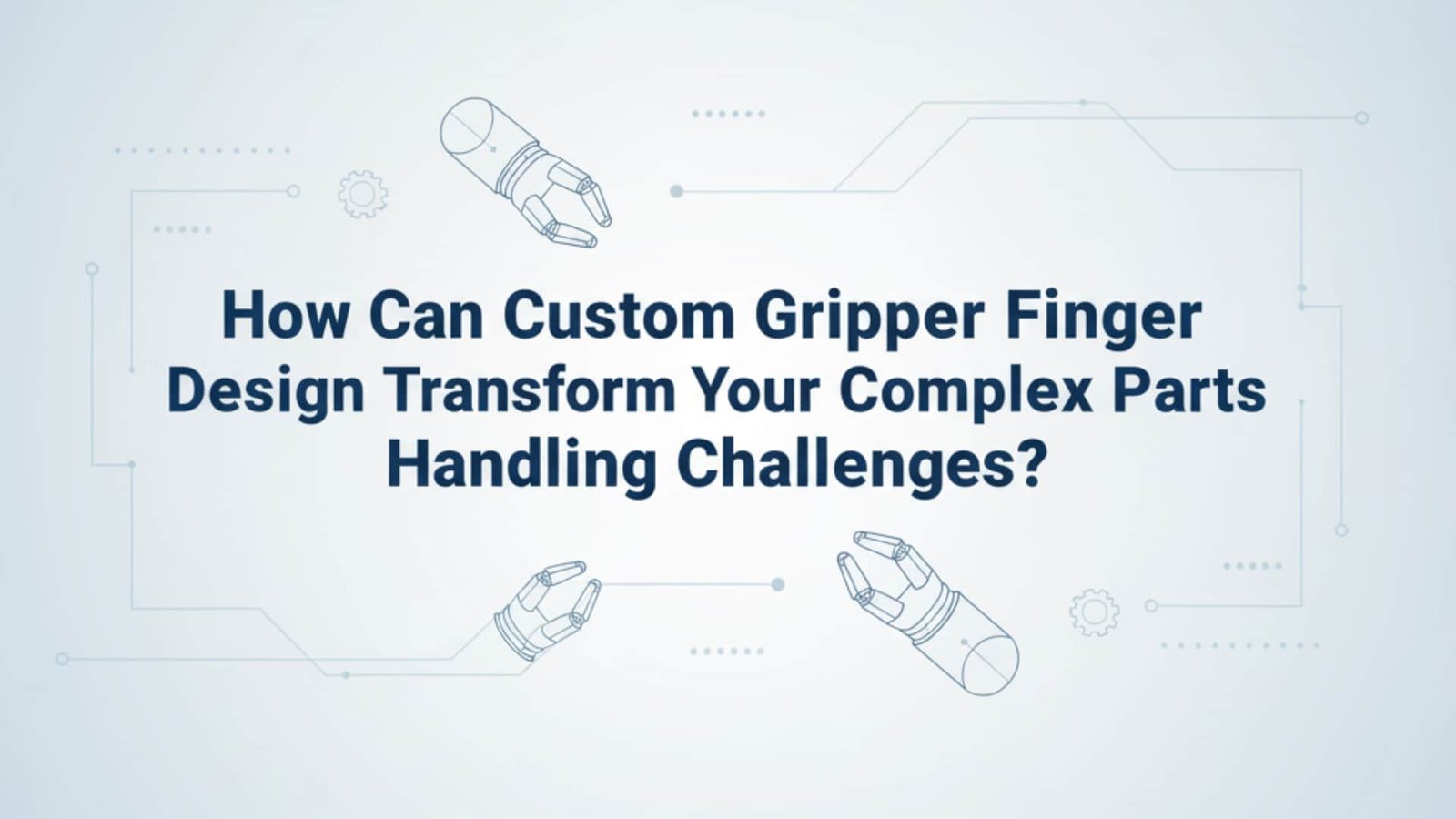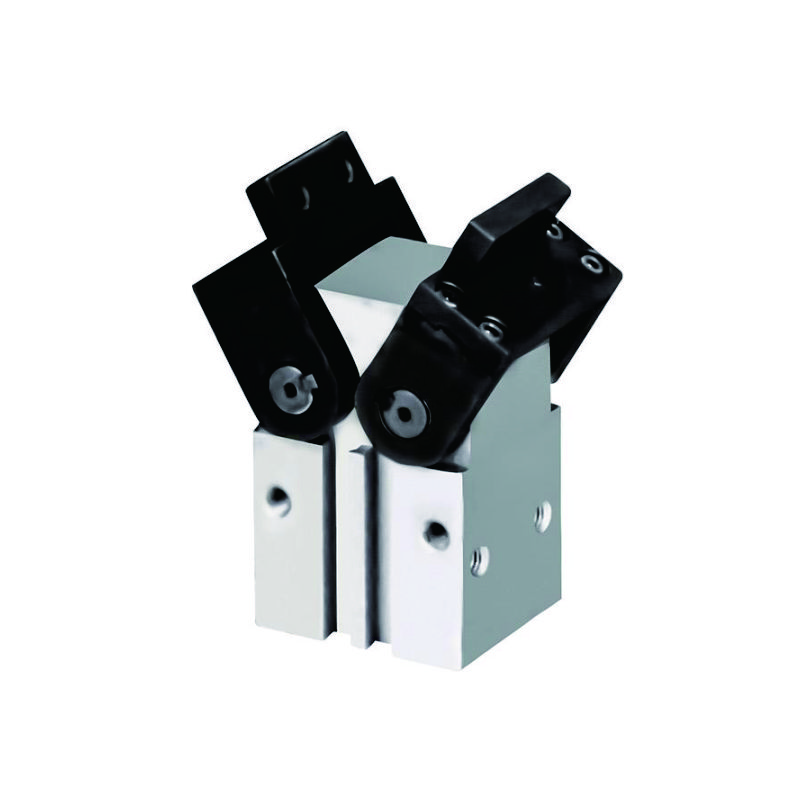When standard gripper fingers fail to handle your complex parts reliably, every dropped component and misaligned workpiece pushes your production costs skyward. These handling failures don’t just slow down your line—they create cascading quality issues that can devastate your entire manufacturing process.
Custom gripper finger design success depends on precise part geometry analysis, material selection based on application requirements, proper force distribution calculations, and integration with compatible pneumatic actuators to ensure reliable gripping performance.
As Chuck, Sales Director at Bepto Pneumatics, I’ve helped dozens of manufacturers overcome their most challenging parts handling scenarios. Just last week, I worked with a facility in Texas that increased their delicate electronics handling success rate from 78% to 99.2% through strategic gripper finger redesign. 🎯
Table of Contents
- What Makes Custom Gripper Finger Design Essential for Complex Parts?
- How Do You Calculate Optimal Grip Force for Delicate Components?
- Which Materials Provide the Best Performance for Custom Gripper Applications?
- Why Does Pneumatic Actuator Selection Impact Gripper Finger Success?
What Makes Custom Gripper Finger Design Essential for Complex Parts?
Standard gripper solutions simply cannot accommodate the unique challenges of modern manufacturing complexity.
Custom gripper finger design becomes essential when handling irregularly shaped parts, fragile materials, varying part sizes, or when standard grippers cause damage, positioning errors, or unreliable gripping performance in your specific application.

Complex Part Characteristics Requiring Custom Solutions
Irregular geometries, delicate surfaces, varying weights, and precise positioning requirements all demand specialized gripper finger designs. Off-the-shelf solutions often compromise either part integrity or handling reliability.
Design Considerations for Optimal Performance
- Contact Surface Area: Maximizing grip stability while minimizing pressure points
- Finger Geometry: Matching part contours for secure, damage-free handling
- Force Distribution: Ensuring even pressure across all contact points
- Clearance Requirements: Accommodating part variations and positioning tolerances
I worked with Sarah, a production engineer at an aerospace components facility in Washington. Her team was struggling with a 15% drop rate on complex titanium brackets using standard parallel grippers1. We designed custom curved gripper fingers that matched the bracket geometry perfectly, reducing drops to less than 0.5% while eliminating surface scratches. 🚀
| Custom vs Standard Gripper Comparison | Custom Bepto Design | Standard Solution |
|---|---|---|
| Part Damage Rate | <0.5% | 5-15% |
| Positioning Accuracy | ±0.1mm | ±0.5mm |
| Cycle Reliability | 99.8% | 85-90% |
| Development Time | 2-3 weeks | Not applicable |
How Do You Calculate Optimal Grip Force for Delicate Components?
Precise force calculations prevent both part damage and grip failures in critical applications.
Calculate optimal grip force by determining minimum holding force based on part weight and acceleration, then apply safety factors while staying below material damage thresholds—typically 1.5-2x minimum force for rigid parts, 1.2-1.5x for delicate components.

Force Calculation Methodology
- Static Force Requirements: Part weight × gravity × safety factor
- Dynamic Force Additions: Acceleration forces during movement
- Material Limitations: Maximum allowable surface pressure
- Environmental Factors: Temperature, vibration, and contamination effects
Pneumatic System Integration
Our rodless cylinders provide the precise force control needed for custom gripper applications. The smooth, consistent motion eliminates force spikes that can damage delicate parts or cause grip failures.
Advanced Force Control Techniques
- Pressure Regulation: Fine-tuning grip force through precise air pressure control
- Feedback Systems: Real-time force monitoring for consistent performance
- Adaptive Gripping: Automatic force adjustment based on part detection
Which Materials Provide the Best Performance for Custom Gripper Applications?
Material selection directly impacts gripper finger durability, part protection, and long-term performance.
Aluminum alloys offer excellent strength-to-weight ratios for general applications, while specialized polymers like PEEK provide chemical resistance and low friction, and rubber compounds deliver superior grip on smooth surfaces without marking.
Material Selection Matrix
- Aluminum 6061: Lightweight, machinable, cost-effective for most applications
- Stainless Steel: High strength, corrosion resistance for harsh environments
- PEEK Polymer2: Chemical resistance, low friction, FDA compliance
- Urethane Compounds: High grip, mark-free contact, vibration dampening
Surface Treatment Options
Various coatings and treatments can enhance gripper finger performance:
- Anodizing3: Improved wear resistance and surface hardness
- Rubber Overmolding: Enhanced grip without part marking
- Textured Surfaces: Increased friction for challenging materials
At a medical device facility in North Carolina, we helped engineer Michael solve a critical handling challenge with sterile glass vials. Standard metal grippers were causing micro-fractures, leading to costly product losses. Our custom PEEK gripper fingers with specialized surface texturing eliminated breakage while maintaining the sterile environment requirements. 💊
Why Does Pneumatic Actuator Selection Impact Gripper Finger Success?
The actuator provides the foundation for all gripper finger performance characteristics.
Pneumatic actuator selection determines grip force consistency, positioning accuracy, cycle speed, and long-term reliability—making rodless cylinders4 ideal for custom gripper applications due to their precise control, compact design, and smooth operation characteristics.
Rodless Cylinder Advantages for Gripper Applications
- Precise Force Control: Consistent grip pressure throughout the stroke
- Compact Design: Minimal space requirements in tight automation layouts
- Smooth Operation: Eliminates vibration that can cause part damage
- High Cycle Life: Reliable performance in demanding production environments
Integration Considerations
Proper actuator sizing ensures optimal gripper finger performance:
- Force Requirements: Matching actuator output to calculated grip forces
- Speed Control: Balancing cycle time with gentle part handling
- Positioning Accuracy: Achieving required grip positioning tolerances
- Environmental Compatibility: Selecting appropriate seals and materials
Bepto Advantage in Custom Applications
Our rodless cylinders integrate seamlessly with custom gripper finger designs, providing the precise control and reliability needed for complex parts handling. We offer rapid prototyping support and can modify standard units to meet specific application requirements.
Conclusion
Custom gripper finger design transforms complex parts handling challenges into competitive advantages through precise engineering, proper material selection, and compatible pneumatic actuator integration.
FAQs About Custom Gripper Finger Design
Q: How long does custom gripper finger development typically take?
A: Development time ranges from 2-4 weeks depending on complexity, including design, prototyping, and testing phases. We accelerate this process through our extensive experience and rapid prototyping capabilities.
Q: Can custom gripper fingers handle multiple part variations?
A: Yes, adaptive gripper finger designs can accommodate part variations through adjustable contact surfaces, flexible materials, or modular finger configurations that adapt to different geometries.
Q: What’s the typical cost difference between custom and standard gripper solutions?
A: Custom gripper fingers typically cost 30-50% more initially but often provide 200-300% ROI through reduced part damage, improved cycle times, and eliminated rework costs.
Q: How do you ensure custom gripper fingers won’t damage sensitive parts?
A: We use finite element analysis5 to optimize contact pressure distribution, select appropriate materials, and conduct extensive testing with actual parts before final implementation.
Q: Are custom gripper fingers compatible with existing automation systems?
A: Most custom gripper finger designs can integrate with existing pneumatic systems, though actuator upgrades may be recommended for optimal performance and reliability.
-
See diagrams of common mechanisms, like cams or linkages, that create the linear motion in parallel grippers. ↩
-
Review the technical data sheet for Polyether Ether Ketone (PEEK), a high-performance thermoplastic known for its mechanical strength and chemical resistance. ↩
-
Learn about the electrochemical process of anodizing and how it creates a durable, corrosion-resistant, and decorative oxide layer on the surface of aluminum. ↩
-
Explore the different types of rodless cylinders, such as magnetically coupled and mechanically coupled, and understand their working principles. ↩
-
Get an overview of Finite Element Analysis (FEA), a computerized method for predicting how a product reacts to real-world forces, vibration, and other physical effects. ↩



